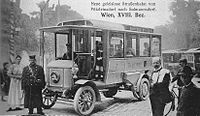Trackless railway Pötzleinsdorf – Salmannsdorf
| Pötzleinsdorf – Salmannsdorf | |||||||||||||||||
|---|---|---|---|---|---|---|---|---|---|---|---|---|---|---|---|---|---|
| Route length: | 2.2 km | ||||||||||||||||
|
|||||||||||||||||
The Gleislose Bahn Pötzleinsdorf – Salmannsdorf was a trolleybus operator in the Austrian capital Vienna .
history
The single line was built on October 14, 1908 by the mayor of Vienna, Dr. Karl Lueger officially opened, the regular service finally began on October 16, 1908. The new means of transport connected the districts of Pötzleinsdorf and Salmannsdorf , the operating company was the car company of the municipality of Vienna . The 2.2 kilometer long route began in Pötzleinsdorf at the terminus of Vienna tram line 41, it led through Pötzleinsdorfer Strasse and Khevenhüllerstrasse to Neustift am Walde and then on to Salmannsdorf. The turning loop was located there between the confluence of Celtesgasse and today's Kotekweg.
In contrast to the tram and bus lines , the Gleislose Bahn did not have a line number. As a result of the switch from left-hand traffic to right -hand traffic on September 19, 1938 , the Gleislose Bahn was shut down on October 30, 1938 because the wagons of the Gleislose Bahn could not be converted with reasonable effort. It was therefore replaced the next day by bus route 23, which, however, had to be closed again on September 6, 1939 due to the war.
From 1946 the end point of the trackless railway was again served by trolleybuses when line 22 was opened from the Währinger Gürtel to Salmannsdorf . It ran until 1958 and followed the track of the trackless railway in the upper area, i.e. for the last 500 meters between Neustift am Walde and the Wendeschleife.
Infrastructure and vehicles
The Mercédès-Électrique-Stoll system was used, so the vehicles used on the Salmannsdorf route also had - as is generally the case with this system - a four-wheeled contact cart for power consumption and wheel hub motors . However, these did not prove themselves and were later replaced by larger motors with a gear ratio. Four motor vehicles were available, which were unusually powered by both axles. Normally, only one of the two axles was driven in the Mercédès-Électrique-Stoll system. The reason for this was the steep inclines and the use of trailers . Driving on the sometimes very steep route required the special skill of the driver, so when stopping on the incline a mountain support had to be operated in addition to the steering wheel and the drive switch .
As a special feature, the line was completely two-lane, then called the four-wire system . There were turning loops at both end points , so there were no air switches . As a further specialty, the Salmannsdorf route was the only Austrian trolleybus operation to survive the First World War . All other four lines laid out at the same time - that is, the electrical overhead line automobile line Gmünd , the electrical overhead line automobile company of the municipality Weidling , the electrical overhead line Liesing – Kalksburg and the Gleislose Bahn Judenburg - were abandoned at the latest in 1920. In addition, the company discussed here was the last in the world to use the outdated contact carts instead of the current collector poles.
The depot was located at Pötzleinsdorfer Straße 100.
See also
literature
- Verlag Slezak (Hrsg.): Obus in Austria . Slezak, Vienna 1979, ISBN 3-900134-62-6
Web links
- Pötzleinsdorf – Salmannsdorf on the website of the trolleybus operation in Vienna ( Memento from June 27, 2009 in the Internet Archive )
- 1908: Trolleybuses in Vienna. on traminator.at, accessed on September 30, 2018
Individual evidence
- ^ Pötzleinsdorf – Salmannsdorf on the trolleybus operation website in Vienna ( Memento from June 27, 2009 in the Internet Archive )
- ↑ District Museum Währing

